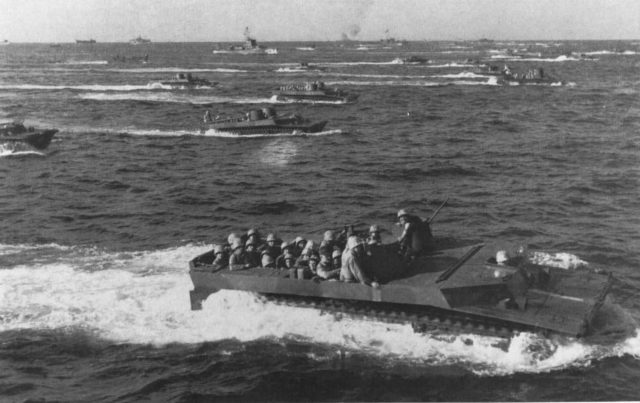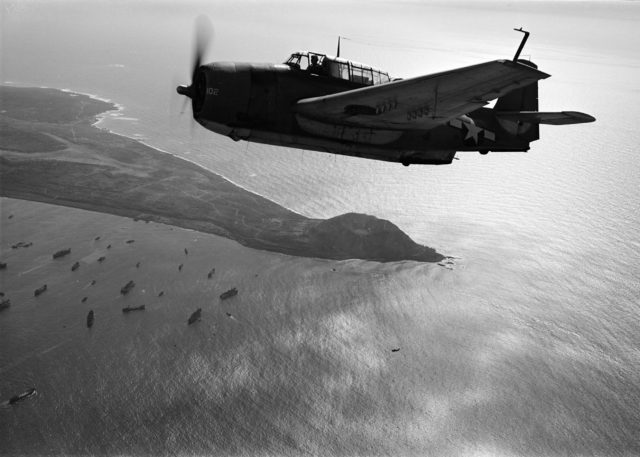Iwo Jima is a small island in the Southeast Pacific; rocky and dominated by a large volcano on its southern peninsula. Today, there is no native population, only military personnel stationed there. It’s an unassuming 8 square mile rock in the middle of the ocean. However, during February and March 1945, it was one of the most important pieces of territory in the world.
On February 19, 1945, the United States launched a massive combined amphibious assault. Wave after wave of Marines landed on the island, eventually taking it from the Japanese after a month of hard fighting.
Events on the island have been adequately covered in books, films, and television. However, not much attention has been given to the men behind the scenes, those working on landing craft, transports, and warships just off the coast.
Gunner’s Mate 1st Class Robert Mullins, US Coast Guard, kept a detailed diary of the invasion. It provides a unique look into his life during this time as witness to the carnage and terror of the battle. Here is a shortened account of Robert Mullins’ experience onboard a Coast Guard manned Landing Ship Tank (LST) from February 19 to March 18, 1945.
February 19
His day started with watch duty at 0345. He saw the bombardment in the distance, flashes of light popping up and down the island. Each one amazingly distant, but to those on the receiving end it would have seemed like the end of the world.
By 0730 the bombardment picked up, and he could just see the outline of the island in the morning light. American Aircraft and 16-inch guns from the battleships opened up on the island, pummeling anything left above the surface.
By 0900 the first Marines hit the beach. Some of these were from the 23rd Marine Regiment, stationed on Mullins’ LST, although he does not give any more information.
- t begins! The Massive fleet of ships pushes forward towards the beaches on the southeastern side of the Island following a massive naval, aerial, and rocket bombardment.
By the night of the 19th, reports started coming back about the fierce Japanese resistance. From the LST Mullins could see the rows of destroyed landing craft, vehicles, and boats. Next to them were row upon row of bodies. The real cost of this invasion had become apparent. There was little Mullins could do but watch from a distance.
Overnight they moved to within 300 yards of the shore. LSTs started running ammunition and supplies back and forth from Mullins’ ship. He was a Gunner’s Mate and in charge of ammunition transfer.
From the deck he watched Marines being shelled all night. He saw three ammunition dumps explode. All were full of supplies just transported to the shore from his ship. Casualties were constantly streaming off the beach to the hospital ships sitting offshore, while fresh ammunition was ferried in from Mullins’ LST and others nearby. The invasion seemed to be going well, but casualties were already high, and ammunition was quickly being used up.

February 20
After a long night of work, the ship was almost unloaded. They were one of the only LSTs left near the shore; the rest had pulled out when the Japanese shelled them. Mullins stated none of the missiles made a direct hit on his craft, but shrapnel was bouncing around the decks.
As dawn broke the American bombardment resumed as the Japanese defense was stiffer than expected. 16-inch shells should solve that problem.
February 21
Japanese planes made a counterattack, damaging some ships in the area. General Quarters and air raid sirens echoed around the fleet, making it almost impossible to get any sleep.
February 22-25
The Marines advance and the naval bombardment continues. The noise must have been deafening; day after day a constant barrage of artillery, rockets, aircraft, and machine gun fire.
Mullins saw first hand, the horror of this battle. The body of a sailor floated past his craft; it was missing limbs and had a lung exposed. A boat was sent out to collect dog tags.
While cleaning a 20 mm cannon, a TBF Avenger was shot down near Mullins’ ship; he saw two men bail out, but it was too low for their parachutes to deploy.
Finally, an LVT came back to the tank deck of the LST. Onboard was a shell-shocked Marine, not sure of his surroundings and terrified.
February 26-29
The LST beached on Iwo, opened its bow doors and prepared to unload ammunition and equipment. Mullins went ashore and stood guard. The Japanese had been counterattacking in the area, and they needed to prevent a boarding. Overnight, mortar shells began landing around their position.
At first, they dug in, hoping to wait it out. The firing steadily increased until the Marine unloading party pulled out. As Mullins was making his way back on board, he saw two Marines nearby shot by snipers. The LST closed its doors, and no one was allowed above deck. They were a stationary target, and Japanese artillery was still able to lob shells at them. The mortar bombardment lasted all night.

On the 28th Mullins went ashore and saw for himself what the naval bombardment had done to the Japanese positions. He describes the horrific stench of death permeating the entire island, with bodies everywhere he looked. He found souvenirs to take home.
When he returned to his ship, they moved out to act as a guard for the rest of the fleet. Unfortunately, while moving into position a 5-inch cannon shell tore through the starboard hull. It was fired by an American ship. The shell took out the generator providing power to their Anti-Aircraft gun turrets, which now had to be operated manually. Amazingly, no one was injured in the accident.
March 1-18
The battle had finally started to wind down. Japanese counterattacks were still occurring, but constant naval and aerial bombardment was pushing them farther and farther back. Mullins’ LST continued supporting operations by ferrying supplies and wounded back and forth. By the 3rd they were one of the few ships left from the original invasion fleet. Despite the constant shelling, shrapnel, and friendly fire, his ship had survived and was able to operate effectively.
Allied aircraft started using the island. Float planes tied up along an artificial dock, and bombers landed on the airfield. At last, the almost nightly air raid sirens stopped, and the crews were able to get some sleep. The operation was completed.
After the Island had been declared fully secure, the LSTs began ferrying Marines onto US Army Transports. Mullins’ final entry is simply “March-18th!”
The horror of Iwo Jima was over, and preparations began for the next assault.
Stories like this fill the gaps in our historical narrative. The American Marines and Japanese Soldiers who fought for Iwo Jima are part of the story; behind them were thousands of support troops, sailors, and airmen. These men made up the majority of those who served in the war, but their stories are too often forgotten.
With Veteran’s Day or Remembrance day just past, we should take a moment to be thankful that such men served.


